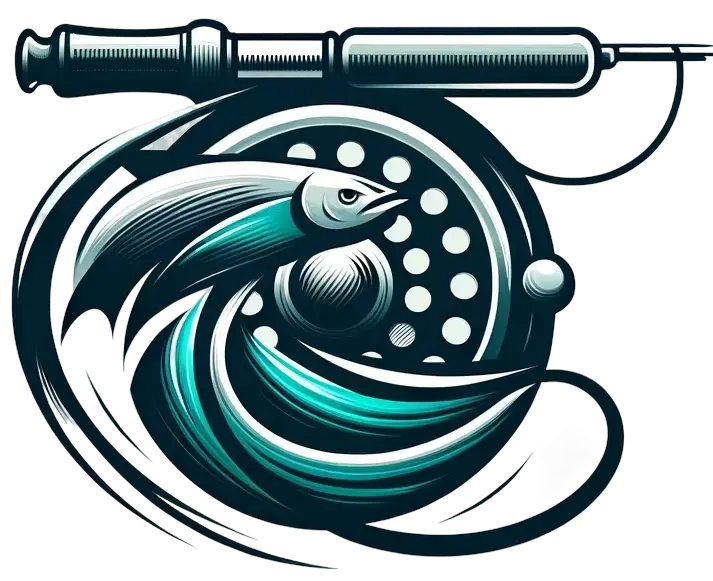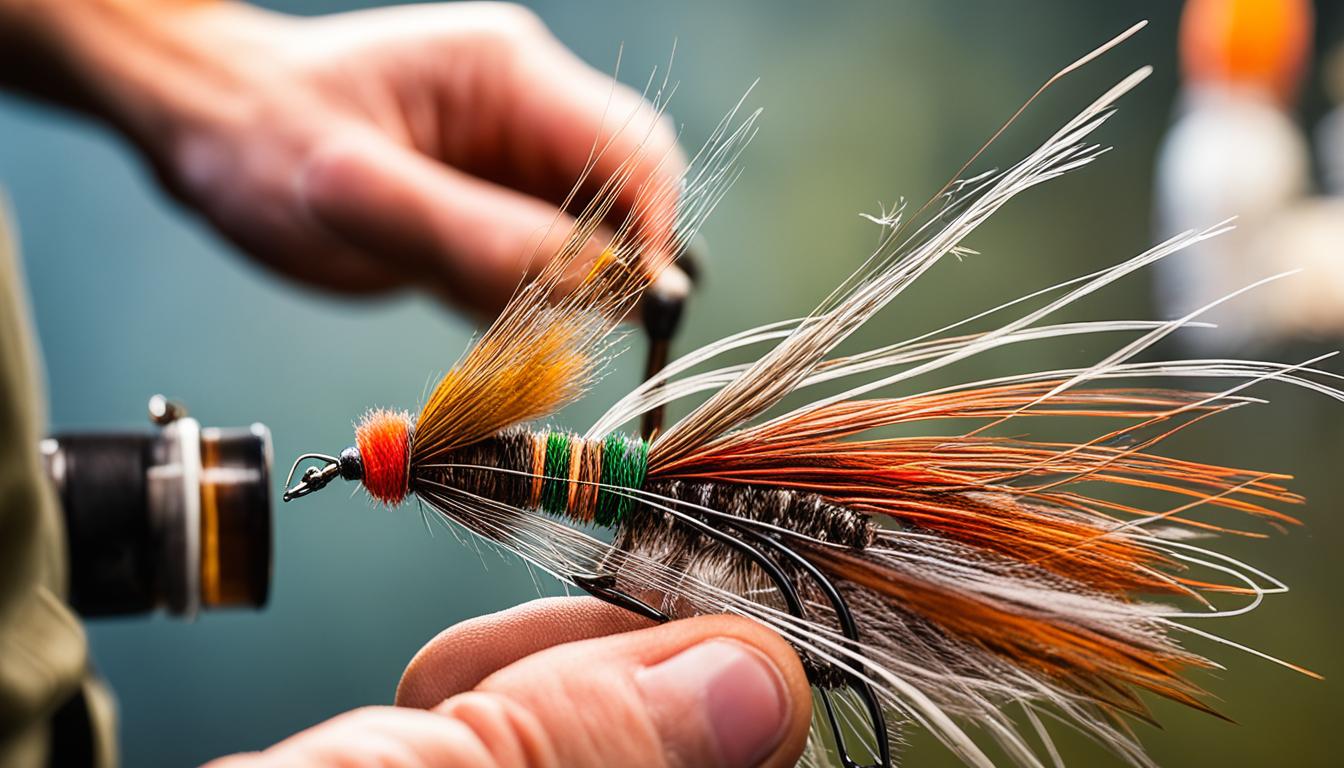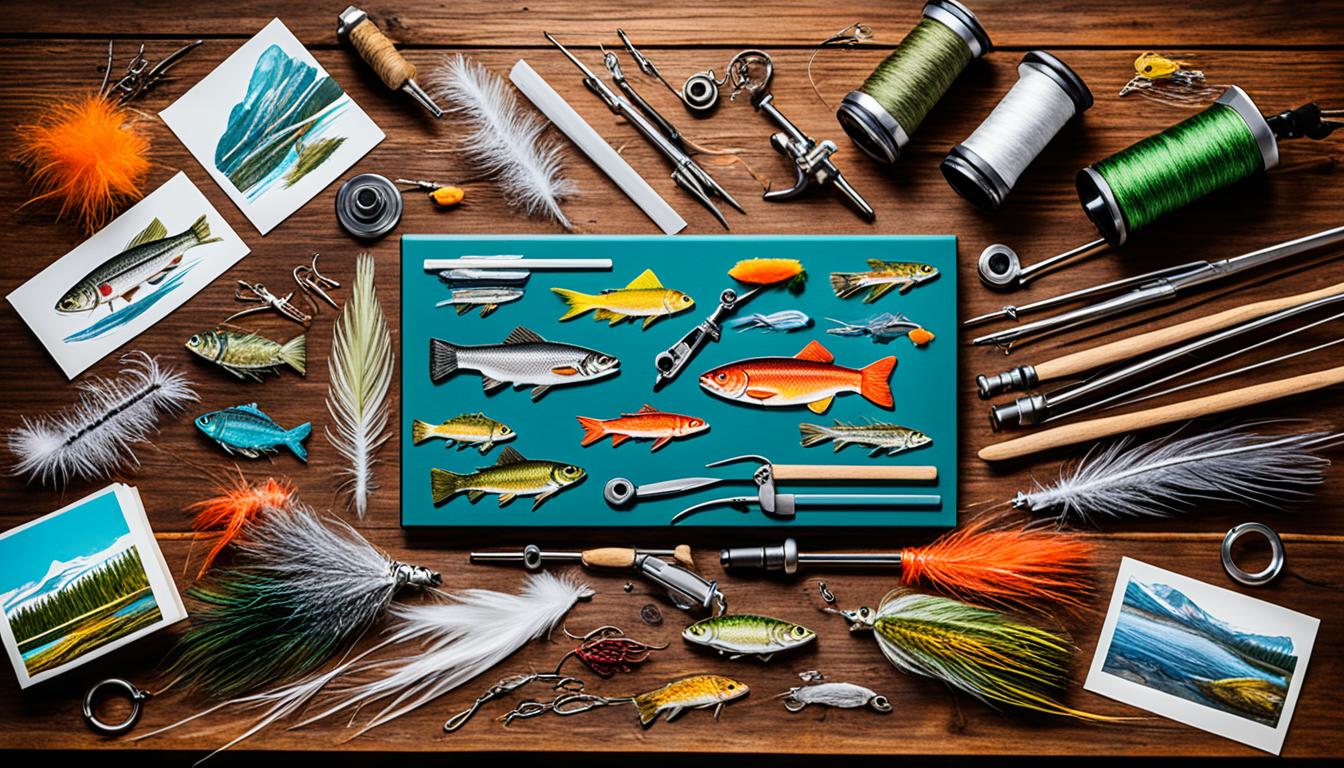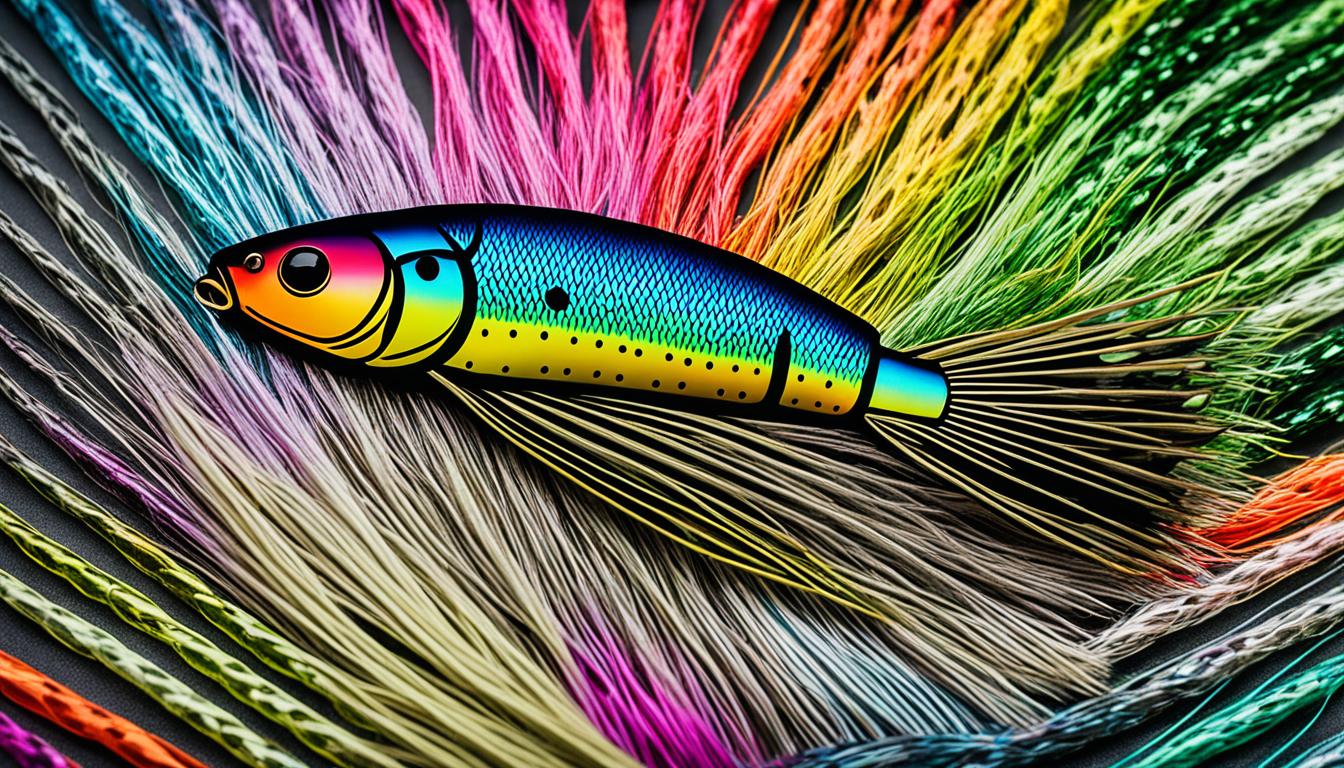Welcome to our comprehensive guide on tying emergers for fly fishing. In this article, we will explore the art of creating effective emergers to imitate emerging insects and enhance your fishing experience. Whether you’re a seasoned angler or new to the sport, mastering the skill of tying emergers can greatly increase your chances of success on the water.
Emergers play a vital role in fly fishing as they imitate insects such as Midges, Mayflies, and Caddis that are hatching out of the water. These insects form a significant part of a trout’s diet, making emergers a must-have in every angler’s fly box. With the right knowledge and techniques, you can effectively mimic the behavior and appearance of these emerging insects, enticing strikes from hungry trout.
Throughout this guide, we will provide you with valuable tips and tricks to help you tie high-quality emergers. We’ll discuss when to use them, the different techniques for fishing with emergers, and the various types of emerger patterns available. By the end of this guide, you’ll be equipped with the knowledge and skills necessary to tie effective emergers that will attract trout in any fishing situation.
Key Takeaways:
- Emergers are essential in imitating emerging insects and can greatly enhance your chances of success in fly fishing.
- Understanding when to use emergers is crucial, and they are particularly effective during hatches and when there is any surface activity.
- Emergers can be fished using different techniques such as the dry fly dropper and tight-line nymphing, allowing you to target trout at various water depths.
- There are different types of emerger patterns, including flush-floating emergers and descending-body emergers, each with its advantages in imitating specific stages of the hatch.
- Mayfly, Caddis, and Midge emerger patterns are popular choices, imitating the behavior and appearance of these common insect species.
When to Use Emergers in Fly Fishing
When it comes to fly fishing, knowing when to use emergers can greatly enhance your chances of success. Emergers should be employed when there is any action on top of the water, such as fish rising to the surface or insect activity in the air. These transitional stages when aquatic insects are emerging from their nymphal or pupal forms are prime opportunities to use emergers.
Emergers are especially effective during hatches, when natural insects are actively emerging. By imitating the emerging insects, you can trigger strikes from feeding trout. However, even when there is no noticeable surface activity, emergers can still entice strikes. Trout are opportunistic feeders and will often feed on emerging insects below the surface as well.
Using emergers allows you to target trout at all levels of the water column. Whether the fish are actively rising or holding deeper, presenting an emerger pattern can tempt them to strike. These patterns imitate the vulnerabilities of the emerging insects, making them irresistible to hungry trout.
It’s important to note that emergers are most effective under specific conditions. They work best when the water temperature is above 50 degrees Fahrenheit, as this is when insect activity is more pronounced. Additionally, clear or slightly stained water conditions are ideal for using emergers, as trout can more easily spot and target these aquatic insect imitations.
When to Use Emergers
| Conditions | Best Time to Use Emergers |
|---|---|
| Surface activity (rising fish or insect activity) | During hatches and whenever fish are actively feeding on top |
| No surface activity | When trout are feeding below the surface or holding at different depths |
| Water temperature | Above 50 degrees Fahrenheit |
| Water clarity | Clear or slightly stained water |
Using emergers in fly fishing requires an understanding of the specific conditions and techniques that maximize their effectiveness. By capitalizing on opportunities when fish are actively feeding on the surface or below, and by imitating the vulnerable stage of emerging insects, you can improve your success rate on the water. Experiment with different fly fishing patterns and techniques to find what works best for you.
Techniques for Fly Fishing with Emergers
When it comes to fly fishing with emergers, anglers have a variety of techniques at their disposal. Two popular and effective methods are the dry fly dropper and tight-line nymphing.
Dry Fly Dropper
The dry fly dropper technique involves using a larger dry fly followed by the emerger. This method allows you to easily track any movement on the water’s surface. By using a dry fly as an indicator, you can see when a fish takes the subtly submerged emerger. It’s important to choose a large dry fly that can support the weight of the emerger without sinking. This technique works particularly well when fish are actively feeding on the surface or during hatch periods.
Tight-Line Nymphing
Tight-line nymphing is a technique that allows you to effectively control the depth and speed of the emerger. It involves minimizing the amount of fly line on the water, using the leader to directly connect with the emerger. This technique requires a tight connection between the angler and the fly, allowing for precise control and subtle movements. By maintaining constant tension on the line, you can detect even the slightest take. This method is especially effective when fishing in deep or fast-moving water where a drag-free drift is crucial.
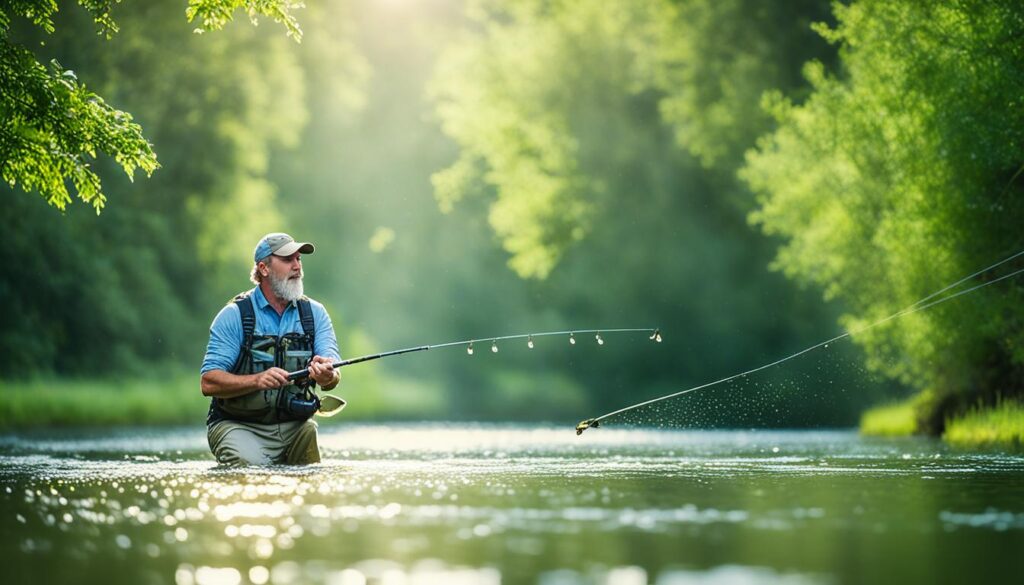
Experimenting with different techniques is key to finding success with emergers. Depending on the fishing conditions and the behavior of the fish, one technique may outperform the other. Keep in mind that each technique requires practice and a good understanding of the water you’re fishing in.
| Technique | Description |
|---|---|
| Dry Fly Dropper | Using a larger dry fly followed by the emerger |
| Tight-Line Nymphing | Controlling the depth and speed of the emerger by minimizing fly line |
Different Types of Emerger Patterns
When it comes to tying emergers, there are two main types of patterns that anglers can use: flush-floating emergers and descending-body emergers. Each type has its own unique characteristics and advantages.
Flush-Floating Emergers
Flush-floating emergers are designed to mimic insects that float on the surface of the water. These patterns are particularly effective during hatches, when insects are emerging from the water. The flush-floating emerger imitates the vulnerable stage of the hatch, attracting trout that are actively feeding on the surface. This type of emerger pattern is commonly used for mayflies and caddisflies.
Descending-Body Emergers
Descending-body emergers partially submerge below the water’s surface, imitating insects as they transition from the water to the air. This type of emerger pattern is ideal for imitating insects during the later stages of the hatch when they are making their way to the surface. Descending-body emergers are often more realistic and can be used to target selective trout that are feeding on insects just below the surface. They are commonly used for midges and other small aquatic insects.
To give you a better understanding, here are some examples of specific emerger patterns:
| Emerger Pattern | Type |
|---|---|
| CDC Midge Pupa | Descending-Body Emerger |
| Barr Emerger | Flush-Floating Emerger |
| RS2 | Descending-Body Emerger |
| Spotlight Caddis Emerger | Flush-Floating Emerger |
Common Types of Emergers: Mayfly, Caddis, and Midge
When it comes to emerger patterns, there are three common types that every fly angler should know – Mayfly, Caddis, and Midge. Each type serves as a specific imitation for these insect species, allowing anglers to match their behavior and appearance.
Mayfly Emerger: Mayflies go through various stages of development, including the nymphal stage where they live underwater before emerging as adults. Mayfly emergers imitate these insects as they transition from nymphs to adults. These patterns often feature slender bodies and trailing shucks to mimic the transformative stage.
Caddis Emerger: Caddisflies also undergo a pupal stage during which they rise to the water’s surface before hatching into adults. Caddis emerger patterns imitate these pupae, featuring segmented bodies and often incorporating materials like antron or Z-lon to create a realistic air bubble effect.
Midge Emerger: Midges are small aquatic bugs that hatch throughout the year, making them an important food source for trout. Midge emerger patterns imitate the pupal stage of these insects, with slender bodies and often incorporating materials like thread or ostrich herl to replicate the delicate appearance of midge pupae.
Each type of emerger has its unique characteristics that make it effective in different fishing situations. By having a selection of mayfly, caddis, and midge emergers in your fly box, you’ll be prepared to imitate the key insect species and increase your chances of catching trout.
Key Features of Mayfly, Caddis, and Midge Emergers:
- Mayfly emerger patterns imitate the transitioning stage from nymph to adult.
- Caddis emerger patterns mimic the pupal stage as caddisflies rise to the surface.
- Midge emerger patterns imitate the delicate pupal stage of midges.
- All three types of emergers serve as specific imitations for their respective insect species.
- Having a selection of mayfly, caddis, and midge emergers in your fly box increases your chances of success in matching the prevailing hatch.
How to Tie an Emerger: The Barr Emerger
One popular emerger pattern that is widely used by fly anglers is the Barr Emerger. This versatile pattern effectively imitates midges, making it a go-to choice for many fly fishermen. The best part is that it is relatively easy to tie and can be customized in different sizes to suit your fishing needs.
Tying Instructions for the Barr Emerger
When tying the Barr Emerger, you’ll need a few fly tying materials. Here’s a step-by-step guide to help you create this effective emerger pattern:
- Start by attaching your thread to the hook and securing it with a few wraps.
- Next, tie in the pheasant tail fibers for the body. These fibers should extend beyond the hook bend, resembling the tail of an emerging insect.
- Add a small amount of dubbing to create the thorax of the emerger. The color of the dubbing can vary depending on the insect you want to imitate.
- Tie in the hackle for the wings. The wings should be positioned upright and slightly spread apart.
- Finally, use elk hair to form the crippled wing of the emerger. This helps create a realistic profile that entices trout.
- Secure all the materials with a few wraps of thread and make sure everything is positioned correctly.
- Finish the fly by tying off the thread, creating a neat head, and applying a small drop of head cement for extra durability.
Remember, the Barr Emerger can be modified to imitate different mayfly species by simply changing the color and size of the materials used. It’s worth experimenting with different variations to see what works best in your fishing waters.
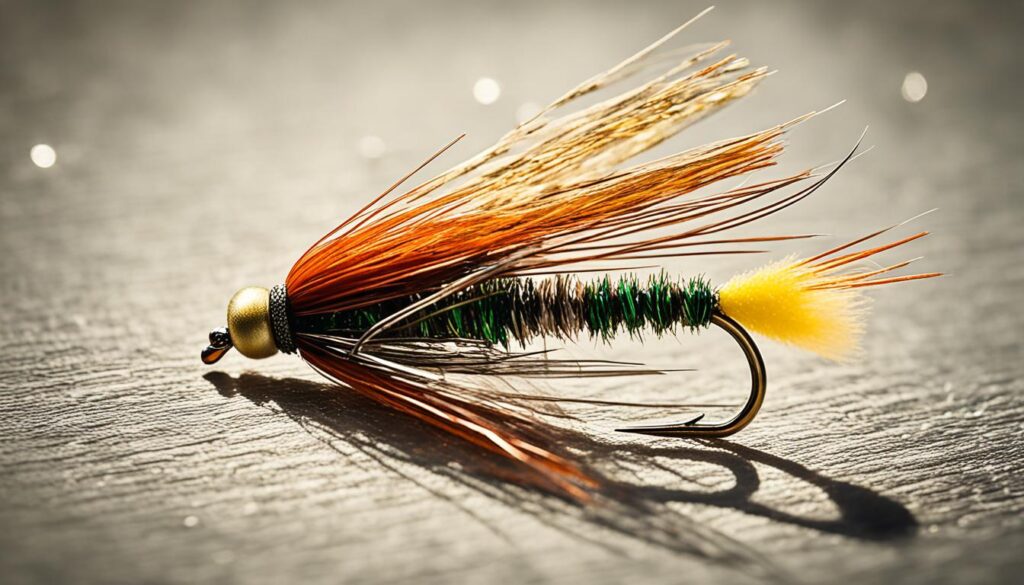
Now that you know how to tie the Barr Emerger, you can add it to your collection of effective emerger patterns. With its realistic appearance and easy customization, this fly will surely attract the attention of trout in search of emerging insects. So grab your fly tying materials and start tying emergers to enhance your fly fishing game!
Conclusion
Fly anglers who master the art of tying emergers can greatly enhance their success on the water. By understanding the different types of emergers, when and how to use them, and experimenting with various patterns and techniques, we can improve our fly fishing game.
Knowing the right fly tying techniques is key to creating effective emergers that mimic the behavior and appearance of hatching insects. Whether it’s tying flush-floating emergers or descending-body emergers, each emerger pattern serves a specific purpose and can be tailored to match different stages of the hatch.
When it comes to fly fishing patterns, targeting trout with emergers is a proven strategy. By imitating emerging insects such as mayflies, caddis, and midges, anglers can entice strikes from trout at all levels of the water column. The versatility of the Barr Emerger, for example, allows us to imitate different mayfly species and increase our chances of success.
So let’s grab our fly tying materials and put our knowledge of emergers into practice. With the right techniques and patterns, we can confidently approach the water, knowing that we have the skills to tempt and deceive trout with these effective imitations. Happy tying and tight lines!
FAQ
What are emergers used for in fly fishing?
Emergers are used to imitate emerging insects such as Midges, Mayflies, and Caddis that are hatching out of the water. They are an important part of a trout’s diet and can be used in various fishing techniques.
When should I use emergers in fly fishing?
Emergers should be used when there is any action on top of the water, such as fish rising or insect activity in the air. They are especially effective during hatches but can also entice strikes when there is no noticeable surface activity. They can be used to target trout at all levels of the water column and are most effective when the water temperature is above 50 degrees Fahrenheit and not muddy.
What are some techniques for fishing with emergers?
Two popular techniques for fishing with emergers are the dry fly dropper and tight-line nymphing. The dry fly dropper method involves using a larger dry fly followed by the emerger, allowing you to track any movement on the water’s surface. Tight-line nymphing allows you to control the depth and speed of the emerger by minimizing the amount of fly line on the water.
What are the different types of emerger patterns?
Emerger patterns are often divided into two main types: flush-floating emergers and descending-body emergers. Flush-floating emergers imitate insects floating on the surface, while descending-body emergers partially submerge below the surface. Each type has its advantages and can be used to imitate different stages of the hatch.
What are some common types of emergers?
Common types of emergers include mayfly, caddis, and midge emerger patterns. Mayfly emergers imitate mayflies as they emerge from the nymphal stage, while caddis emergers mimic the pupae stage of the caddis as they rise to the surface. Midge emergers imitate the pupae of midges, which are small aquatic bugs.
How do I tie an emerger pattern like the Barr Emerger?
To tie a Barr Emerger, you will need black thread, pheasant tail fibers for the body, dubbing for the thorax, hackle for the wings, and elk hair for the crippled wing. The Barr Emerger is a versatile pattern that imitates midges and can be modified to imitate different mayfly species.
How can tying emergers improve my fly fishing game?
Tying emergers is an important skill for fly anglers to master. By understanding the different types of emergers, when to use them, and how to fish them effectively, anglers can increase their chances of success on the water. Experimenting with different patterns and techniques can lead to discovering what works best in specific fishing conditions.
